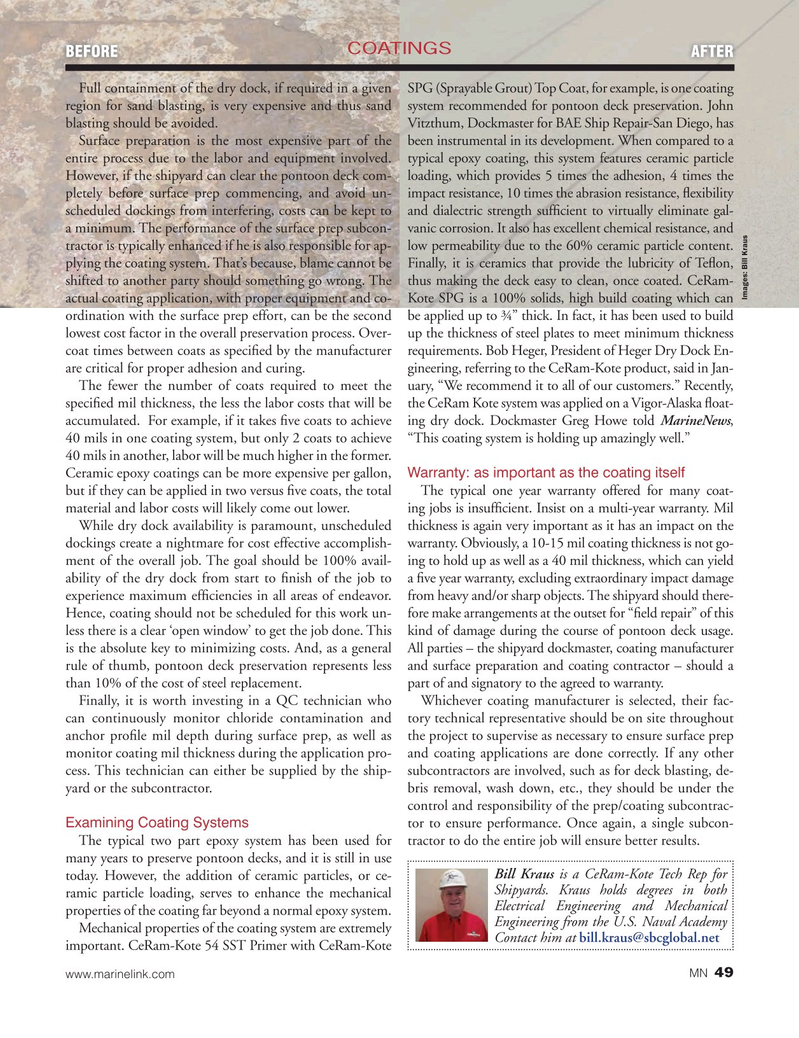
Page 49: of Marine News Magazine (April 2016)
Boatbuilding: Construction & Repair
Read this page in Pdf, Flash or Html5 edition of April 2016 Marine News Magazine
COATINGS
BEFORE AFTER
Full containment of the dry dock, if required in a given SPG (Sprayable Grout) Top Coat, for example, is one coating region for sand blasting, is very expensive and thus sand system recommended for pontoon deck preservation. John blasting should be avoided. Vitzthum, Dockmaster for BAE Ship Repair-San Diego, has
Surface preparation is the most expensive part of the been instrumental in its development. When compared to a entire process due to the labor and equipment involved. typical epoxy coating, this system features ceramic particle
However, if the shipyard can clear the pontoon deck com- loading, which provides 5 times the adhesion, 4 times the pletely before surface prep commencing, and avoid un- impact resistance, 10 times the abrasion resistance, ? exibility scheduled dockings from interfering, costs can be kept to and dialectric strength suf? cient to virtually eliminate gal- a minimum. The performance of the surface prep subcon- vanic corrosion. It also has excellent chemical resistance, and tractor is typically enhanced if he is also responsible for ap- low permeability due to the 60% ceramic particle content. plying the coating system. That’s because, blame cannot be Finally, it is ceramics that provide the lubricity of Te? on, shifted to another party should something go wrong. The thus making the deck easy to clean, once coated. CeRam-
Images: Bill Kraus actual coating application, with proper equipment and co- Kote SPG is a 100% solids, high build coating which can ordination with the surface prep effort, can be the second be applied up to ¾” thick. In fact, it has been used to build lowest cost factor in the overall preservation process. Over- up the thickness of steel plates to meet minimum thickness coat times between coats as speci? ed by the manufacturer requirements. Bob Heger, President of Heger Dry Dock En- are critical for proper adhesion and curing. gineering, referring to the CeRam-Kote product, said in Jan-
The fewer the number of coats required to meet the uary, “We recommend it to all of our customers.” Recently, speci? ed mil thickness, the less the labor costs that will be the CeRam Kote system was applied on a Vigor-Alaska ? oat- accumulated. For example, if it takes ? ve coats to achieve ing dry dock. Dockmaster Greg Howe told MarineNews, 40 mils in one coating system, but only 2 coats to achieve “This coating system is holding up amazingly well.” 40 mils in another, labor will be much higher in the former.
Ceramic epoxy coatings can be more expensive per gallon, Warranty: as important as the coating itself but if they can be applied in two versus ? ve coats, the total The typical one year warranty offered for many coat- material and labor costs will likely come out lower. ing jobs is insuf? cient. Insist on a multi-year warranty. Mil
While dry dock availability is paramount, unscheduled thickness is again very important as it has an impact on the dockings create a nightmare for cost effective accomplish- warranty. Obviously, a 10-15 mil coating thickness is not go- ment of the overall job. The goal should be 100% avail- ing to hold up as well as a 40 mil thickness, which can yield ability of the dry dock from start to ? nish of the job to a ? ve year warranty, excluding extraordinary impact damage experience maximum ef? ciencies in all areas of endeavor. from heavy and/or sharp objects. The shipyard should there-
Hence, coating should not be scheduled for this work un- fore make arrangements at the outset for “? eld repair” of this less there is a clear ‘open window’ to get the job done. This kind of damage during the course of pontoon deck usage. is the absolute key to minimizing costs. And, as a general All parties – the shipyard dockmaster, coating manufacturer rule of thumb, pontoon deck preservation represents less and surface preparation and coating contractor – should a than 10% of the cost of steel replacement. part of and signatory to the agreed to warranty.
Finally, it is worth investing in a QC technician who Whichever coating manufacturer is selected, their fac- can continuously monitor chloride contamination and tory technical representative should be on site throughout anchor pro? le mil depth during surface prep, as well as the project to supervise as necessary to ensure surface prep monitor coating mil thickness during the application pro- and coating applications are done correctly. If any other cess. This technician can either be supplied by the ship- subcontractors are involved, such as for deck blasting, de- yard or the subcontractor. bris removal, wash down, etc., they should be under the control and responsibility of the prep/coating subcontrac-
Examining Coating Systems tor to ensure performance. Once again, a single subcon-
The typical two part epoxy system has been used for tractor to do the entire job will ensure better results.
many years to preserve pontoon decks, and it is still in use
Bill Kraus is a CeRam-Kote Tech Rep for today. However, the addition of ceramic particles, or ce-
Shipyards. Kraus holds degrees in both ramic particle loading, serves to enhance the mechanical
Electrical Engineering and Mechanical properties of the coating far beyond a normal epoxy system.
Engineering from the U.S. Naval Academy
Mechanical properties of the coating system are extremely
Contact him at [email protected] important. CeRam-Kote 54 SST Primer with CeRam-Kote 49 www.marinelink.com MN
MN April16 Layout 32-49.indd 49 3/18/2016 10:59:22 AM

 48
48

 50
50
